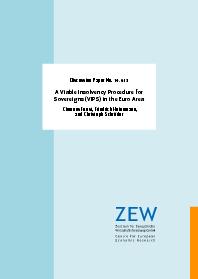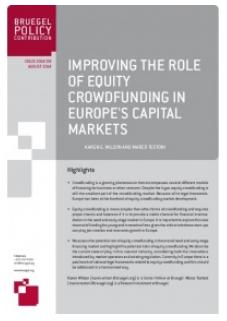Delgado, M., Ketels, C., Porter, M. & Stern, S. (2014) “Deep roots or current policies – what drives sustained prosperity differences across locations?“, VoxEU Organisation, 18 September. There is a consensus among economists that ‘deep roots’ – geography, natural endowments, and institutions – are important determinants of prosperity differences across countries. This column argues that deep roots matter, but they are neither the whole story nor an excuse for …Read More
Entry and Exit in OTC Derivatives Markets
Atkeson, Α., Eisfeldt, Α. & Weill, P. O. (2014) “Entry and Exit in OTC Derivatives Markets“, VoxEU Organisation, 17 September. Entry and trading in over-the-counter (OTC) derivatives markets have received considerable attention. However, many critical questions remain unaddressed. This column describes a formal study of banks’ incentives to enter and trade in OTC derivatives markets. In equilibrium, only large banks enter to become dealers, and middle-sized banks only enter …Read More
A Viable Insolvency Procedure for Sovereigns (VIPS) in the Euro Area
Fuest, C., Heinemann, F. & Schröder, C. (2014) “A Viable Insolvency Procedure for Sovereigns (VIPS) in the Euro Area“, Centre for European Economic Research (ZEW), Discussion Paper No. 14, August. The euro area debt crisis has revealed serious flaws in the institutional setup of the European Monetary Union (EMU) as it had been designed in the late 1990s (Buti and Carnot, 2012; Hodson, 2013). Although the establishment of a …Read More
Why does Italy not grow? – The Italian economy has barely grown since it joined the euro area in 1999
Mody, Α. & Riley, Ε. (2014) “Why does Italy not grow? – The Italian economy has barely grown since it joined the euro area in 1999“, Bruegel Institute, 09 September. In April this year, the Italian debt-to-GDP ratio was expected to peak by year-end at 135 percent of GDP. That projection assumed a real GDP growth rate of 0.6 percent and inflation of about 0.7 percent. The projected decline …Read More
A ‘sovereign subsidy’ – zero risk weights and sovereign risk spillovers
Korte, J. & Steffen, S. (2014) “A ‘sovereign subsidy’ – zero risk weights and sovereign risk spillovers“, VoxEU Organisation, 07 September. European banking regulation assigns a risk weight of zero to sovereign debt issued by EU member countries, making it an attractive investment for European banks. This column defines a ‘sovereign subsidy’ as a new measure quantifying to what extent banks are undercapitalised due to the zero risk weights. …Read More
Fiscal Convergence in the European Union before the Crisis
Bertarelli, S., Censolo, R. & Colombo, C. (2014) “Fiscal Convergence in the European Union before the Crisis“, Contemporary Economic Policy, Volume 32, Issue 4, pp. 784–801, October 2014. This article investigates fiscal convergence attained by EU countries in the period 1991–2008, by employing β- and σ-convergence techniques complemented by a time series analysis. Overall our results highlight a distinctive convergence pattern in the European Union. Fiscal discipline leading to …Read More
Improving the role of equity crowdfunding in Europe’s capital markets
Wilson, Ε. Κ. & Testoni, M. (2014) “Improving the role of equity crowdfunding in Europe’s capital markets“, Bruegel Organisation, 29 August. Crowdfunding is a growing phenomenon that encompasses several different models of financing for business or other ventures. Despite the hype, equity crowdfunding is still the smallest part of the crowdfunding market. Because of its legal framework, Europe has been at the forefront of equity crowdfunding market development. Equity …Read More
European Bond Market: Bubble of all Bubbles!
EconMatters (2014) “European Bond Market: Bubble of all Bubbles!“, Global Market Economics Matters, 27 August. European Bond Rush Right now investors in European Bonds are running over each other all in an effort to front run what the Big Banks have been begging the ECB to begin a bond buying program similar to the United States’ QE bond buying program. Tourism has its Limitations It is hilarious as European …Read More
How to jumpstart the Eurozone economy
Giavazzi, F. & Tabellini, G. (2014) “How to jumpstart the Eurozone economy“, VoxEU Organisation, 21 August. The stagnating Eurozone economy requires policy action. This column argues that EZ leaders should agree a coordinated 5% tax cut, extension of budget deficit targets by 3 or 4 years, and issuance of long-term public debt to be purchased by the ECB without sterilisation. The mantra is that once again it is up …Read More
European Economy, Evaluating Fiscal Policy – A Rule of Thumb
Carnot, N. (2014) “European Economy, Evaluating Fiscal Policy – A Rule of Thumb“, European Commission – Economic Papers 526, August. This paper introduces a simple rule for appraising the economic soundness of fiscal policies. It connects fiscal policy to a long-run debt objective, taken as an anchor, while arbitraging symmetrically between this debt objective and output stabilisation. The rule offers a benchmark to assess the evolution of primary expenditure, …Read More








